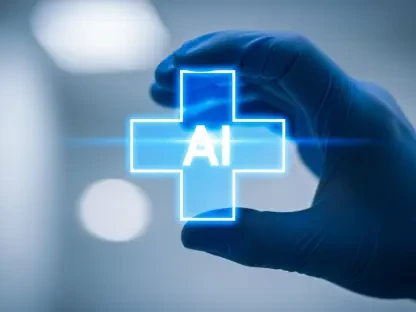The intersection of AI and healthcare has accelerated sharply in 2025. Just recently, OpenEvidence, an AI platform designed for medical professionals, was prepared to announce a $200 million funding round at a $6 billion valuation. The raise follows a $210 million round just three months earlier that valued the company at $3.5 billion, highlighting the surge of investor demand for specialized AI in healthcare.
Hospitals, clinics, and research institutions are deploying AI tools to transform a range of processes, from diagnostics and patient monitoring to predictive analytics. In addition, clinical AI systems are now capable of analyzing radiology images with accuracy that rivals or exceeds human specialists, while natural language processing supports doctors by summarizing medical notes and identifying overlooked risk factors. Operationally, AI is helping administrators optimize staff schedules, predict equipment failures, and manage patient flow in real time.
The momentum is undeniable, but it comes with a dividing line. Hospitals that adopt AI with structured governance and strategic intent position themselves for improved care quality, lower costs, and stronger resilience under pressure.
AI in healthcare has become a prerequisite for staying relevant in a sector defined by both human lives and razor-thin margins. Continue reading to explore insights into embracing modern tools in healthcare.
The Case for Clinical Integration
AI has matured beyond pilot programs or narrow use cases. In diagnostics, algorithms trained on millions of radiology images now detect abnormalities with remarkable speed and accuracy, reducing the chance of missed findings and supporting clinicians in high-pressure environments.
Moreover, pathology labs are deploying AI models to identify complex patterns in tissue samples that might otherwise escape human detection, while dermatology practices rely on image recognition systems to differentiate between benign and malignant lesions. Across imaging disciplines, AI is acting as a precision amplifier, strengthening the quality and consistency of clinical decisions.
A systematic review in JMIR found that AI-based clinical decision support systems (“AI-CDSSs”) assist healthcare workers by predicting patient outcomes and recommending optimal interventions.
Beyond detection, predictive analytics has entered the clinical mainstream. By analyzing patient history, comorbidities, and treatment data, AI models generate early warnings for complications or readmission risks. This empowers hospitals to use insights to:
Intervene proactively;
Allocate resources more effectively;
And reduce strain on emergency departments.
The result is a shift from reactive care to a preventive strategy, where clinicians can anticipate outcomes and act before problems escalate.
Decision support systems powered by AI now extend into personalized treatment planning. These platforms integrate patient data, genomic information, and the latest clinical guidelines to recommend tailored therapies. Instead of one-size-fits-all approaches, physicians can weigh AI-informed options that match each patient’s individual profile. This accelerates the path to effective treatment while reducing trial-and-error approaches that drive up costs and prolong recovery.
Operational Advantages
AI adoption is transforming the operational backbone of healthcare delivery. Workflow automation now handles tasks that once consumed valuable clinician time, including documentation, appointment scheduling, and routine administrative updates. In supply chain management, AI systems track inventory levels, predict usage patterns, and flag potential shortages, ensuring that essential materials remain available without excess cost or waste. These capabilities free staff from repetitive work and allow them to focus on direct patient care.
Hospitals are also applying AI to optimize resources with greater precision. Staffing levels can be adjusted in real time based on patient volume forecasts, ensuring that clinicians are neither overextended nor underutilized. Predictive models monitor equipment usage and maintenance cycles, reducing downtime and extending the life of costly assets. Bed management platforms powered by AI analyze admissions and discharge data, identifying bottlenecks and recommending reallocation strategies that keep patient flow steady. The result is more efficient use of personnel, infrastructure, and capital.
Hospitals are applying AI to optimize resources with greater precision. Predictive models forecast patient volumes to adjust staffing in real time, ensuring clinicians are neither overextended nor underutilized. The same systems track equipment usage and maintenance cycles, reducing downtime and extending the lifespan of costly assets.
Bed management platforms analyze admission and discharge data to identify bottlenecks and recommend reallocations that keep patient flow steady. As reported by NetSuite, these applications demonstrate how AI strengthens back-office operations by aligning staff, infrastructure, and capital more effectively.
Enhancing the Patient Experience
AI is reshaping the patient journey by making care more accessible, responsive, and personal. Virtual assistants and conversational AI are now handling common questions, guiding patients through pre-visit preparation, and supporting post-discharge instructions. These tools reduce confusion, keep patients engaged between appointments, and create a channel for continuous communication without overwhelming clinical staff.
Remote monitoring adds another layer of engagement and safety. Wearable devices and connected sensors transmit real-time health data to AI platforms that detect anomalies, trigger alerts, and recommend interventions before conditions worsen. This capability supports proactive care, enabling clinicians to reach patients at the first sign of trouble rather than waiting for hospital readmissions. For individuals managing chronic conditions, the reassurance of ongoing oversight builds trust and confidence in the system. Research shows hybrid chatbots in healthcare to:
Reduce readmissions by as much as 25%.
Increase patient engagement by around 30%.
Cut wait times by approximately 15%.
Operational improvements powered by AI also translate directly into a smoother care experience. Predictive scheduling reduces bottlenecks that create long wait times, while AI-driven bed management ensures faster transitions between departments. Patients encounter fewer delays, clearer instructions, and more coordinated interactions across the continuum of care. The cumulative effect is an environment where technology enhances rather than complicates the experience, leaving patients with greater satisfaction and a stronger sense of agency in their treatment.
Conclusion
The urgency for action has never been sharper. AI has progressed beyond an experiment at the edges of healthcare. Today, it serves as part of the infrastructure on which modern hospitals run.
Intelligent systems already shape diagnostics, operations, and patient engagement. They deliver speed, accuracy, and foresight. Waiting for proof of concept is no longer an option because the evidence is already visible in measurable outcomes. Hospitals that embrace AI with a clear strategy will set the pace for the sector. Responsible integration strengthens efficiency, elevates clinical outcomes, and builds lasting trust with patients and communities. Those who lead now define the standards for care delivery in the years ahead.
Addressing inefficiency and patient dissatisfaction in today’s AI-driven landscape hinges on harnessing modern tools. Embrace AI in your hospital to establish a robust, value-driving foundation for healthcare leadership.









